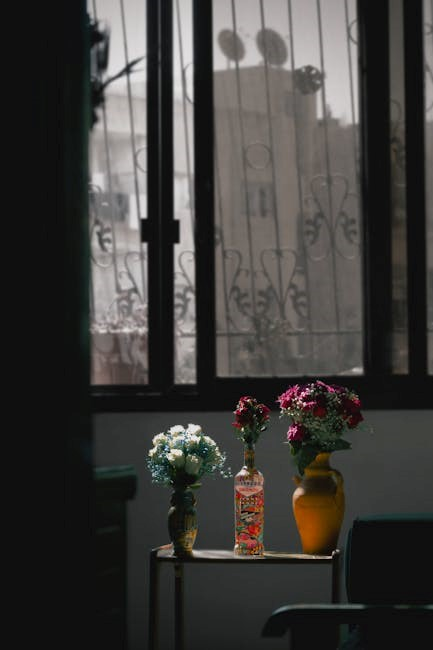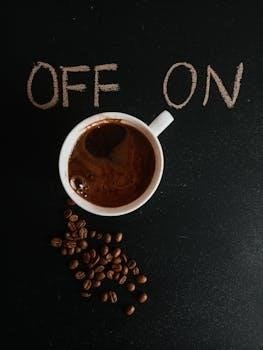The Philips Avent Bottle Warmer is a premium, efficient solution for safely warming baby bottles and food jars, combining smart technology with a user-friendly, innovative design․
1․1 Overview of the Product
The Philips Avent Bottle Warmer is a versatile, electric appliance designed to safely and evenly warm baby bottles and food jars․ Compatible with Avent bottles and baby food containers, it features smart temperature control and water bath technology to prevent overheating․ Models like the SCF358 offer automatic shut-off for added convenience․ This product is ideal for parents seeking a reliable, efficient, and easy-to-use solution for warming breast milk, formula, or baby food, ensuring a stress-free feeding experience for both parents and baby․
1․2 Key Features of the Philips Avent Bottle Warmer
The Philips Avent Bottle Warmer features smart temperature control to prevent overheating, ensuring safe and even warming of milk and baby food․ It utilizes water bath technology for consistent heating and is compatible with Avent bottles and food jars․ The device includes automatic shut-off for added convenience and energy efficiency․ Designed with a compact and user-friendly interface, it allows for easy operation and cleaning․ Models like the SCF358 offer advanced functionality, making it a reliable choice for parents seeking a high-quality bottle warming solution․
Key Benefits of Using the Philips Avent Bottle Warmer
The Philips Avent Bottle Warmer ensures fast, gentle, and even heating, preserving essential nutrients in milk and baby food․ Its user-friendly design makes feeding time easier and less stressful for parents, while the smart temperature control prevents overheating, ensuring safety and convenience for both babies and caregivers․
2․1 Fast and Even Warming
The Philips Avent Bottle Warmer heats bottles and baby food jars quickly and evenly, ensuring consistent temperatures without hot spots․ This advanced warming technology preserves the nutritional value of milk and food while providing a safe and efficient solution for feeding time․ Parents can rely on its rapid performance, making it ideal for busy schedules․ The even heating also prevents overheating, safeguarding the quality of the contents and ensuring a comfortable feeding experience for babies․
2․2 Smart Temperature Control
The Philips Avent Bottle Warmer features smart temperature control, ensuring bottles and food jars are heated to the ideal temperature without overheating․ This intelligent system maintains a consistent warmth, preserving the nutritional value of breast milk and baby food․ The warmer automatically adjusts to prevent excessive heat, making it a safe and reliable choice for parents․
Its intuitive design allows for easy operation, providing peace of mind during feeding preparation․ This feature is particularly beneficial for safeguarding sensitive nutrients in breast milk and baby meals․
2․3 Compatibility with Avent Bottles and Baby Food Jars
The Philips Avent Bottle Warmer is specifically designed to work seamlessly with Avent bottles and baby food jars, ensuring optimal performance and safety․ This compatibility guarantees a secure fit and even heating, making it ideal for parents who rely on Avent products for their baby’s feeding needs․
The warmer supports various Avent bottle sizes, including the popular SCF358 and SCF355 models, as well as Avent baby food jars․ This versatility allows parents to heat bottles and meals efficiently, making mealtime convenient and stress-free․

Safety Guidelines for Using the Bottle Warmer
Always follow safety guidelines to ensure safe operation․ Keep the warmer out of children’s reach, avoid overheating, and never leave it unattended during use․
3․1 General Safety Precautions

Always place the bottle warmer on a stable, heat-resistant surface away from children․ Ensure the appliance is out of reach to prevent accidental burns or injuries․ Never submerge the warmer in water or expose it to excessive moisture․ Avoid overheating by following the recommended temperature settings and times․ Keep the power cord away from hot surfaces or water to prevent damage․ Regularly inspect the device for signs of wear or damage․ Unplug the warmer when not in use or during cleaning to ensure safety․ Always follow the manufacturer’s guidelines to minimize risks and ensure safe operation․
3․2 Electrical Safety Tips
Avoid submerging the bottle warmer in water or exposing it to excessive moisture․ Ensure the power cord is kept away from hot surfaces, water, or sharp objects․ Regularly inspect the cord for damage or fraying and avoid using it if compromised․ Do not overload the electrical outlet or use extension cords․ Keep the warmer away from flammable materials․ Always unplug the device when not in use or during cleaning to prevent electrical hazards․ Follow these guidelines to ensure safe and reliable operation․

Step-by-Step Instructions for Using the Philips Avent Bottle Warmer
Plug in the warmer, add water, and set the temperature․ Place the bottle or jar inside, close the lid, and wait for the indicator․ Once ready, carefully remove and serve․
4․1 Preparing the Bottle Warmer
Start by plugging in the Philips Avent Bottle Warmer and placing it on a flat, stable surface․ Ensure the warmer is clean and free from any damage․ Before first use, wash the interior with warm water and mild soap, then rinse thoroughly․ Dry the warmer with a soft cloth to prevent water spots․ Make sure all accessories, like the measuring cup, are within reach․ Finally, familiarize yourself with the control panel and settings to ensure smooth operation․
4․2 Adding Water and Setting the Temperature
To begin, pour the recommended amount of water into the warmer using the provided measuring cup․ Avoid overfilling to ensure even heating․ Next, place the bottle or food jar into the warmer․ Use the control panel to set the desired temperature, choosing from options for breast milk, formula, or baby food․ The warmer will automatically start heating once the temperature is set․ Allow the cycle to complete, which typically takes 2-3 minutes for milk and slightly longer for frozen items․ Always monitor the process to ensure safe and efficient warming․
4․3 Placing the Bottle or Food Jar in the Warmer
Align the bottle or food jar with the warmer’s opening, ensuring it fits securely․ Gently lower it into the water, making sure the lid is tightly sealed․ The bottle should be submerged to the recommended level, indicated by markings on the warmer․ For food jars, place them upright to prevent spills․ Ensure compatibility with Avent bottles and jars for optimal performance․ Once placed, double-check the position to avoid uneven heating or water splashing․ Close the lid to start the warming cycle;
4․4 Monitoring the Warming Process
Once the bottle or jar is placed inside, monitor the warming process closely․ Check the temperature indicator to ensure it reaches the desired level․ Use the timer to track progress, and avoid overheating by following the recommended warming times․ Keep an eye on the water level to prevent drying out․ Do not leave the warmer unattended, especially when heating breast milk or sensitive foods․ Always check the bottle or jar’s temperature before serving to ensure it’s safe for your baby․ This step ensures safe and effective warming․
4․5 Removing and Serving the Bottle or Food

Once the warming cycle is complete, carefully remove the bottle or food jar using the provided tongs or oven mitts to avoid burns․ Check the temperature by gently shaking the bottle or testing a small amount on your wrist․ If using breast milk or formula, ensure it’s not too hot․ Pour or serve the contents immediately․ For baby food, stir well before serving․ Always clean the warmer after use to maintain hygiene and prevent residue buildup․ This ensures a safe and efficient feeding process․

Maintenance and Cleaning of the Bottle Warmer
Regularly clean the warmer with a soft, damp cloth․ Avoid abrasive cleaners or bleach․ Descale every 1-2 months to prevent mineral buildup․ Dry thoroughly after cleaning․
5․1 Cleaning the Exterior and Interior
For the exterior, wipe with a soft, damp cloth, avoiding harsh chemicals․ For the interior, rinse with warm water and mild soap․ Descale regularly using a vinegar solution to remove mineral deposits․ Soak removable parts like the basket or lid in warm soapy water․ Dry thoroughly after cleaning to prevent bacterial growth․ Regular cleaning ensures optimal performance and hygiene, keeping your Philips Avent Bottle Warmer in excellent condition for safe and effective use․
5․2 Descaling the Warmer
Descaling the Philips Avent Bottle Warmer is crucial to remove mineral buildup from hard water․ Mix equal parts water and white vinegar in the warmer․ Let it soak for about 30 minutes to loosen deposits․ After soaking, rinse thoroughly with clean water to remove any residue․ For tougher buildup, repeat the process․ Regular descaling ensures proper heating and prevents damage to the warmer․ This maintenance step keeps your Philips Avent Bottle Warmer functioning efficiently and prolongs its lifespan․
5․3 Storing the Warmer When Not in Use
When storing the Philips Avent Bottle Warmer, ensure it is clean and dry to prevent mold or mildew growth․ Store it in a cool, dry place away from direct sunlight and moisture․ Keep it out of children’s reach and avoid stacking heavy items on top to prevent damage․ If storing for an extended period, consider placing it in its original packaging for added protection․ Proper storage maintains the warmer’s functionality and longevity when not in use․
Troubleshooting Common Issues
Identify common issues like uneven heating or malfunction․ Check power supply, clean sensors, and ensure proper water levels․ Refer to the manual for detailed solutions․
6․1 The Warmer is Not Turning On
If the Philips Avent Bottle Warmer fails to turn on, check the power cord and outlet․ Ensure the warmer is properly plugged in and the outlet is functional․ Verify that the power button is pressed correctly and not stuck․ Clean any debris from the electrical contacts․ If issues persist, consult the user manual or contact Philips Avent customer support for assistance․ Always follow safety guidelines when troubleshooting electrical appliances․
6․2 The Water is Evaporating Too Quickly
If water evaporates too fast, ensure the lid is securely closed during use․ Check the water level and avoid overfilling, as this can cause rapid evaporation․ Place the warmer away from direct sunlight or heat sources․ Clean the warmer regularly to prevent mineral buildup, which may affect performance․ Refer to the user manual for guidelines on water quantity and maintenance․ Proper usage will help maintain efficiency and prevent excessive water loss․
6․3 The Bottle is Not Warming Evenly
If the bottle isn’t warming evenly, ensure the water level is appropriate and the bottle is properly positioned․ Avoid overfilling, as this can disrupt heat distribution․ Check for any blockages in the warmer’s heating chamber․ Clean the warmer regularly to remove mineral deposits, which can impede performance․ Ensure the bottle is compatible with the warmer and isn’t too large or small․ If issues persist, refer to the user manual for troubleshooting or contact customer support for assistance․
Comparing Philips Avent Bottle Warmer with Other Models
Philips Avent stands out for its efficient heating and compatibility with Avent bottles, offering a user-friendly design․ Other models may lack its seamless integration and reliability․
7․1 Philips Avent SCF358 vs․ SCF355
The Philips Avent SCF358 and SCF355 are both popular bottle warmers, but they differ in features․ The SCF358 offers an automatic shut-off and faster warming, while the SCF355 is more basic․ Both models are compatible with Avent bottles and ensure even heating․ The SCF358 is ideal for busy parents needing quick results, whereas the SCF355 is a cost-effective option for those seeking simplicity․ Both are reliable, but the SCF358 provides added convenience with its advanced features․
7․2 Philips Avent vs․ Chicco Bottle Warmers
Philips Avent and Chicco bottle warmers cater to similar needs but differ in design and functionality․ Philips Avent models are known for their smart temperature control and compatibility with Avent bottles, while Chicco warmers often feature digital controls and multi-functionality․ Philips Avent tends to be more compact, whereas Chicco may offer more versatility in accommodating different bottle sizes․ Both brands prioritize safety and even heating, but the choice depends on specific features and compatibility with your baby’s feeding essentials;

User Reviews and Feedback
Users praise the Philips Avent Bottle Warmer for its efficiency and ease of use, while some note durability concerns over time․ Parents appreciate its consistent performance․
8․1 Positive Experiences with the Philips Avent Bottle Warmer
Many parents highlight the Philips Avent Bottle Warmer’s ability to quickly and evenly warm bottles, making it a lifesaver for late-night feedings․ Its compact design and ease of use are frequently praised, while the compatibility with Avent bottles ensures a seamless experience․ Users also appreciate the gentle warming process, which helps preserve nutrients in breast milk․ The device’s intuitive controls and consistent performance have made it a favorite among busy families, offering convenience without compromising on safety or efficiency․
8․2 Common Complaints and Suggestions for Improvement
Some users report that the Philips Avent Bottle Warmer can be slow for larger bottles or frozen breast milk․ Others mention that the warming process can sometimes be inconsistent, requiring adjustments․ A few parents find the design bulky and wish for a more compact option․ Additionally, the lack of a timer and automatic shut-off feature is a point of contention․ To improve, users suggest adding these features and enhancing compatibility with varying bottle sizes for a more universal product․
FAQs About the Philips Avent Bottle Warmer
FAQs include questions about cleaning, compatibility with other bottles, and whether it has an automatic shut-off feature․ Users also ask about heating times and suitability for breast milk․
9․1 Can the Warmer be Used for Frozen Breast Milk?
The Philips Avent Bottle Warmer is not designed to thaw frozen breast milk directly․ However, it can be used to warm breast milk that has been thawed in the refrigerator or under cold running water․ Always ensure the milk is completely thawed before warming to maintain safety and nutrients․ Follow the manufacturer’s guidelines for temperature control to avoid overheating, which can damage the milk’s nutritional properties․
9․2 Is the Warmer Suitable for All Types of Baby Bottles?

The Philips Avent Bottle Warmer is primarily designed for use with Philips Avent baby bottles and food jars․ While it may accommodate certain other bottle brands, compatibility varies depending on the bottle’s size and shape․ For optimal performance and safety, it’s recommended to use Philips Avent bottles․ Always check the dimensions and material compatibility before using other brands to ensure proper fitment and function․
9․3 Does the Warmer Have an Automatic Shut-Off Feature?
The Philips Avent Bottle Warmer does not have an automatic shut-off feature on all models; Certain models may include this function, but it varies depending on the specific product version․ Always refer to the user manual for details about your particular unit․ For models without this feature, monitoring the warming process is recommended to avoid overheating or excessive energy use․
The Philips Avent Bottle Warmer is a reliable and efficient solution for parents, offering ease of use and safety features that ensure optimal baby care․
10․1 Final Thoughts on the Philips Avent Bottle Warmer
The Philips Avent Bottle Warmer is a reliable and efficient solution for parents seeking convenience and safety․ Its user-friendly design, smart temperature control, and compatibility with Avent products make it a top choice․ It ensures evenly warmed bottles and baby food, which is essential for newborns․ While it may have minor drawbacks, its overall performance and durability justify its popularity․ For parents prioritizing ease and safety, this warmer is a practical investment for daily use․

10․2 Recommendations for Potential Buyers

If you’re considering the Philips Avent Bottle Warmer, prioritize ease of use and compatibility with your baby bottles․ Check if it fits your budget and meets your specific needs, such as warming speed and multiple bottle capacity․ Read reviews to ensure it aligns with your lifestyle․ Consider durability and maintenance requirements․ Finally, compare it with similar models to confirm it’s the best fit for you and your baby․
















